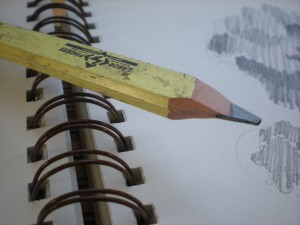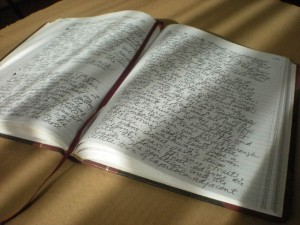Savage Grace
“I put my heart and my soul into my work, and have lost my mind in the process.”
—Vincent Van Gogh

Decisions
One, abandon all work in anything but oils. Two, spend at least two years sketching the landscape before attempting to paint it. Three, move to California. After reading an article, in the early 90s, about something called “plein air”, and deciding that plein air was the direction I would take, these were the three decisions I made…and kept. Embodied in those two words, plein air, I saw artistic challenge, physical, mental, and spiritual challenge, and a fiercely brave community, and nothing was going to keep me away from what I perceived as a fledgling “movement”.
Positive Thinking
Living on the East Coast, I had only painted in the studio in acrylic, I was also a professional illustrator in watercolor, ink, scratchboard, you name it. For me, oils had always been “the real thing”. So, the next time I would paint would be in oils. Even though I had never painted in oils, I figured how hard could it be? No problem switching from acrylic to watercolor to scratchboard to pen and ink to conte to charcoal to paper sculpture.
Though I loved the landscape, I did not understand the forms and structures, the
nuances of it. Start like a beginner, I said, pencil and paper. Sketch the landscape, not draw it, sketch it, until I could see it clearly. Plain paper in a wire binder, a carpenter’s pencil to prevent fussing over details. Sketch, sketch, sketch. Carry it everywhere. Waiting in the car? Get out and sketch that tree, any tree. Two years. Fill notebook after notebook. Then, and only then, paint.
Getting back to California, my home state, was the tricky part. A graphic designer/illustrator is rarely hired from the East Coast to the West Coast. It just doesn’t happen. Having a job was essential, I had a wife, a new baby. When, in the early 90s, I saw the web for the first time, I also saw my ticket back to California: Become a web designer. As implausible as this sounds now, I taught myself, built a portfolio and, within two years, I was working for Apple. All for plein air.
The New Good Ol’ Days
After all that positive thinking, it sounds like such a negative thing to say, doesn’t it?: “Why the Plein Air Movement is Dead”? Life is such a personal journey. Everyone’s perspective on their experiences differs one from another so it would seem fair to tag on two more words at the end of that sentence: “for Me”. “Why the Plein Air Movement is Dead…for Me”.
But a personal essay is inherently unfair and narrow and, in the end, only opinion. So that is the context in which I speak and, although I respect the perspectives of the current population of plein air painters, I am not going to tag on those two words “for me” because I think I speak the heart, or at least the suspicions, of many of us old-timers, one might say early-adopters. In the spirit of the good ol’ days, a ridiculous notion I admit, but an easy enough metaphor as long as we don’t buy into it too much, I think it will be helpful to paint a picture of what it was like back in the cave man days of plein air painting. Back before demos, classes, magazines, websites, workshops, competitions, and conventions.
We will not go back as far as the days of Lascaux or Altamira; those artists were not plein air painters (see my essay “What is Plein Air?”. Nor do I refer to the fascinating and inspiring, but now ancient, history of the original plein air movement embodied in the paintings of the plein air impressionists whose paintings are often referred to as Early California Impressionism. It isn’t the good ol’ days of those early impressionists, either, the first painters who took up that new-fangled invention, the paint tube, back in the days before plein air even had a name or over-reaching self-consciousness. (Imagine Vincent saying “I think I’ll paint ‘plein air’ today.”). Really?
No, I mean the recent good ol’ days, the past 20 years or so, when there was a sudden rediscovery of the idea and a revival of the practice of plein air painting. Back in the days of just sketching until you were sick of sketching, before you even know how to paint in oils. This was a time of potential. Landscapes were still landscapes, waiting to be appreciated, honored and wrestled onto a canvas for the sake of the wrestling. That was the goal, that was the entire joy and entire end, and if you could share your trophy with comrades, all the better. They knew your struggles, they would encourage you, and you them. After all, few of us were experts…yet.
Of the Landscape
But many of us were dedicated. The sound of the word dedication contains the aural seed of something more serious, something to be taken seriously. Yet, somehow, plein air was life and one knew that, because death was always in the background, in a subtle way. In my 50s I was hauling a heavy French easel and all my other gear and canvases as far as four miles up into the mountains above the tech giants in that famous valley below. I felt my mortality as the weight of the gear burned my muscles and, on those sunny days, sweat trickled into my eyes, and not a hand free to wipe it away.
You find your spot. A fine spot. With a view. With everything you need. Amazing how the landscape composes itself, for there are compositions everywhere if you have but an eye to see. Perhaps not another person in sight. Almost never another painter to be seen. Lonely work. Alone with yourself, your thoughts, your challenges. You might be tempted to talk to yourself. But no, get to work, the sun is moving, no time for idle chatter. Stay focused. Nail that landscape. Use that muscle memory you built up in two years of sketching. Put the paint on, put it on, put it on. Burn under the sun, legs trembling from standing so long because you have to stand in order to stay focused. Focus, focus, focus. Find the flow, trust, ride with it.
You step back in exhaustion. What’s this? The little group of five deer you had noted in the distance perhaps an hour, or hours, ago, are standing around you. You could reach out and touch them. They were drawn to you. How unusual, they thought, this one doesn’t move. It is still and quiet for long periods of time. We like that. We shall stand close to it.
I have had deer, coyote, bob cat, fox, and all manner of bird come within inches of me while I work. Usually they just pass on by, like I am a tree or a bush. They don’t see a human, those frenetic noisy dangerous creatures, they see peace, stillness, perhaps kindness. When this happens while painting, it gives one a perspective on our species that is both disheartening and encouraging. Disheartening because we are such noisy creatures that we fill little hearts with fear. Encouraging because we can see clearly that when we are peaceful, the peace spreads to the innocent. You, the artist painting plein air, are not in the landscape, like humans. You are of the landscape, like the plants and the animals.
Another Hero for Campbell’s Soup
Just as a reminder, Joseph Campbell’s classic hero archetype goes like this. The protagonist leaves the “world”, that is daily life, ventures into the unknown, wrestles with forces, is mentored by others, lays hands on the prize, and, as Campbell put it, brings back a “boon” to humankind. Call me corny, I really do not care, but I have always seen these paint outs as heroic and myself as a hero. (Please, do not bring up military heroism; it should be clear that I am using the classic Campbell idea here.)

It was my practice in the first few years to keep a journal and to make an entry after every paint out. Some of those entries read like a book because I had not begun painting until the end of those two years of sketching preparation. Taking up my brush, seeing it almost as a sword, I began my adventure. One might say misadventures, given my inability to paint yet. The first time I painted plein air was the first time I ever painted in oil. No teacher but the sun, the land, threes and animals and hours at the canvas, time after time.
For me, plein air painting was, especially in those early days when it was such a lonely pursuit, an heroic adventure and the artist was the hero. Follow Joseph Campbell’s template: The artist ventures out of the world of ordinary life and its ordinary pursuits in order to do battle with his own body, his own mind, and the thriving, living world around him, to wrest the prize of something that did not exist prior to his going in search of it. Through this great labor, and under challenging conditions, he lays hands on it, by the grace of God, and brings it back, a prize and a boon for all humankind.
Where once nothing had existed and where there was no vision, now exists a tangible and beautiful thing, a thing that delights the eye and speaks to the world of his vision, and his struggle, and, best of all, shows us something that we may have missed completely, the world around us.
###
Next Post: Why the Plein Air Movement is Dead, Part Three, in which I attempt to show how this vision has been co-opted by market forces and monetized resulting in the commoditization of the movement; and I’ll offer some ideas on how to go forward.


One thought on “Why the Plein Air Movement is Dead, Part Two”